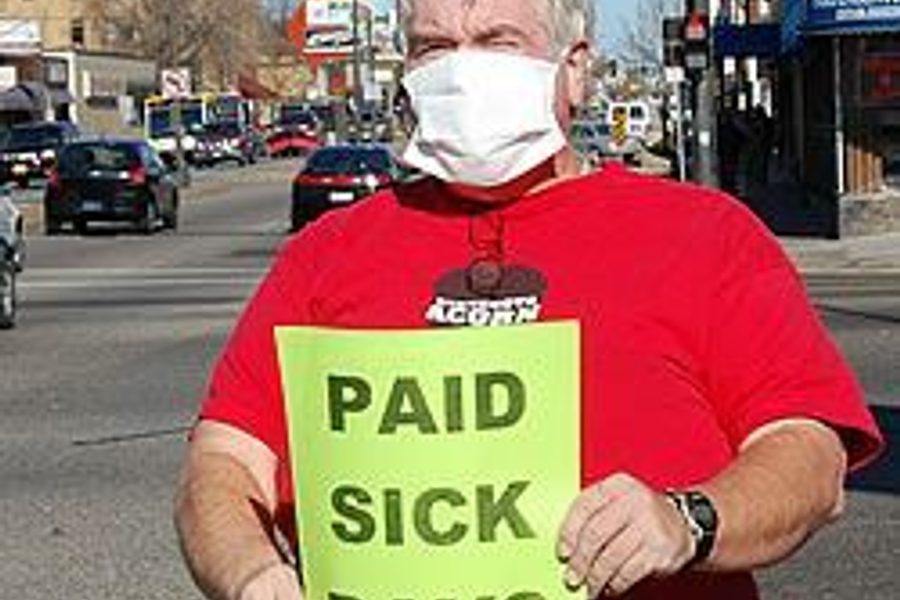
When families are hit with both health problems and financial hardship, they often can’t afford to deal with either.
But if a parent can’t go to work because she’s sick, and can’t make rent without work, having a paid day off could help her avoid an impossible choice between getting well and getting paid.
In New York City, the recession, the healthcare crisis, and now, the threat of an approaching flu epidemic, are forming a perfect storm that could lead to a government mandate for paid sick leave.
Civil rights and economic justice groups are backing a City Council bill to let workers earn, based on the hours they put in, up to nine paid sick days annually, or five days for smaller employers.
According to a survey by the Community Service Society, “about 1.5 million workers in New York City are not entitled to any paid sick leave,” including a majority of low-income workers. Nationwide, the vast majority of low-wage worker households have no paid sick days.
That means people are going to work while sick. According to a survey conducted last year by the National Opinion Research Center (NORC) at the University of Chicago (full disclosure: the survey was commissioned by the Public Welfare Foundation, which financially supports Working In These Times), 68 percent of respondents lacking paid sick days said “yes” when asked, “Have you ever had to go to work when you were sick with a contagious illness like the flu or a viral infection?”
And many employees who do have personal paid sick days can’t use that time to care for an ailing child. The federal Family and Medical Leave Act provides for unpaid sick days for time off due to family health issues or childbirth.
But New York City’s proposal for paid sick days would go a step further by protecting families’ earnings. Campaigns for similar legislation have cropped up in states and cities across the country.
San Francisco enacted a landmark ordinance in 2007 directing employers to allow paid sick time for full- and part-time workers. The law also enables individuals to sue employers who don’t comply.
In Congress, the proposed Healthy Families Act would provide workers at companies with 15 or more employees with up to seven paid sick days per year.
Some business groups have argued that it would hurt their bottom line to provide employees paid time off work to tend to health needs.
Advocates counter that, far from hurting economic security, paid sick days help employers retain staff and prevent turnover. An analysis by the Institute for Women’s Policy Research found that the San Francisco ordinance would on balance actually save the city more money than it would cost.
Besides, sick workers could undermine public health by transmitting illness to colleagues on the job. The spread of the H1N1 virus across New York City adds another layer of urgency to the campaign for paid sick days.
Aside from the practical benefits, the paid sick leave debate revolves around workplace equity. Following gender, racial and class divisions in the workforce, those with the least to fall back on have the most to lose when illness strikes. Conversely, an extra few days per year makes it more feasible for a low-income mother to raise a family while advancing herself economically.
According to the Institute for Women’s Policy Research, “47 percent of women working in the private sector have no paid sick days” and “27 percent of low-income women… put off getting health-care because they cannot take time off from work. 18 percent of women at all income levels face this situation.”
Most women working in low-wage industries, like waitressing and child care, lack paid sick days. The Urban Institute points out that paid leave is also in extremely short supply among working welfare recipients.
While this simple benefit is out of reach for millions of Americans, it’s the status quo in many other countries. And one economic analysis of other nations’ employee leave policies found “no evidence of a negative relationship between paid leave for personal or family health needs and macro-economic status.”
Paid time off for sick workers would address just one of the countless problems plaguing the healthcare system. But the movement for a fair leave policy is a sign that more American communities are taking the rest of the world’s medical advice: it pays to be healthy.
Michelle Chen is a contributing writer at In These Times and The Nation, a contributing editor at Dissent and a co-producer of the “Belabored” podcast. She studies history at the CUNY Graduate Center. She tweets at @meeshellchen.








